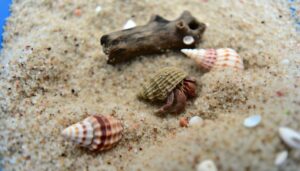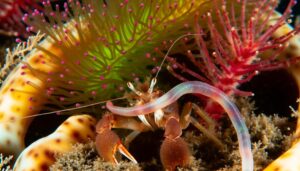Do Hermit Crabs Like Company?
Yes, female hermit crabs lay fertilized eggs. They carry these eggs attached to their pleopods, which they use for aeration and protection.
Mating involves complex rituals like tapping and drumming, influenced by environmental factors such as lunar cycles. To guarantee successful fertilization, males often carry females, synchronizing movements to position correctly.
For eggs to develop, you need to maintain specific temperature (75-85°F) and humidity (70-80%) levels. Females meticulously monitor these conditions, ensuring their eggs' survival.
Understanding these precise behaviors and environmental needs provides deeper insights into hermit crab reproduction and offspring development.

Key Takeaways
- Female hermit crabs lay eggs that they carry and aerate with pleopods.
- Eggs are attached to the female's pleopods for oxygenation and protection.
- Ideal temperature and humidity levels are crucial for successful egg incubation.
- Females show dedication to offspring survival through aeration and protection of eggs.
- Replicating natural conditions in captivity supports egg-laying and development.
Hermit Crab Reproduction
During their reproductive phase, hermit crabs engage in complex mating rituals that are necessary for successful fertilization. You'll notice that these rituals involve specific behaviors, such as tapping and drumming, which help crabs communicate readiness and compatibility. Research shows that environmental factors like lunar cycles and tidal movements greatly influence their reproductive timing.
When you observe them closely, you'll see males often carry females for days until mating occurs, ensuring best conditions for fertilization. These behaviors are essential, as they increase the chances of sperm transfer and subsequent egg laying. By understanding these rituals, you can better support their reproductive health in both wild and captive environments. Your role is important in fostering conditions that facilitate these natural behaviors.
Mating Process
In the initial phase of the mating process, you'll observe males perform a unique courtship display, which includes rhythmic tapping and drumming on the female's shell to signal readiness and suitability. These behaviors aren't merely instinctual; they're finely tuned signals that help the female evaluate the male's fitness.
You'll notice the male positioning himself at the opening of the female's shell, often engaging in a gentle rocking motion. This tactile communication is essential for the female to accept or reject the male.
Researchers have found that successful mating often involves synchronization of these movements, ensuring both crabs are in best posture. Observing these behaviors reveals the delicate and precise nature of hermit crab courtship.
Egg-Laying Behavior
Female hermit crabs, after successful mating, exhibit a fascinating behavior where they meticulously carry and aerate their fertilized eggs with specialized appendages until hatching. You'll notice that these appendages, known as pleopods, play an essential role in ensuring the eggs receive adequate oxygen and remain free from harmful debris.
This egg-laying behavior involves several key steps:
- Attachment: The female carefully attaches the eggs to her pleopods, using a sticky substance to secure them.
- Aeration: She rhythmically moves her pleopods to facilitate oxygen flow, vital for embryonic development.
- Protection: The female remains vigilant, protecting the eggs from potential predators and environmental hazards.
These behaviors highlight the female hermit crab's dedication to ensuring the survival of her offspring.
Incubation Period
You'll need to maintain specific temperature and humidity levels to guarantee successful incubation of hermit crab eggs. Research shows that ideal conditions include temperatures around 75-85°F and humidity levels between 70-80%.
These parameters are essential for proper egg development, progressing through stages from zygote to larva.
Temperature and Humidity Requirements
Maintaining ideal temperature and humidity levels is essential for the successful incubation of hermit crab eggs. You should aim for a temperature range of 75-85°F (24-29°C) and humidity levels between 70-80%.
These conditions closely mimic their natural tropical habitats and support proper egg development.
To achieve this, follow these steps:
- Temperature Regulation: Use a reliable aquarium heater to uphold consistent warmth, preventing fluctuations that could harm the eggs.
- Humidity Control: Employ a hygrometer to monitor humidity and mist the enclosure regularly to keep levels within the desired range.
- Airflow Management: Guarantee adequate ventilation to prevent mold growth while retaining necessary humidity.
Egg Development Stages
Once the ideal temperature and humidity levels are maintained, the hermit crab eggs undergo several distinct stages of development during the incubation period.
Initially, the eggs appear opaque, shifting to a more translucent state as they mature.
Around the midpoint, you'll observe the formation of eye spots, indicating the development of embryonic structures.
By the final stages, the eggs become noticeably darker due to the presence of fully formed larvae ready to hatch.
Throughout this period, it's essential to monitor environmental conditions closely, ensuring stability to support best development.
Research indicates that fluctuations in temperature or humidity can adversely affect embryonic growth, potentially leading to high mortality rates.
Your attention to these details greatly impacts the successful hatching of healthy larvae.
Hatching Process
The hatching process of hermit crab eggs begins with the larval stage known as the zoea, which emerge from the eggs after a specific incubation period. You'll observe that the incubation period can vary based on environmental factors such as temperature and salinity.
Once the zoea hatch, they undertake a critical journey to the ocean where they'll continue their development. To guarantee successful hatching:
- Monitor environmental conditions: Maintain ideal temperature and salinity levels.
- Provide safe progression: Ensure a direct path to the ocean for newly hatched zoea.
- Minimize disturbances: Reduce vibrations and noise to prevent stress on the hatching larvae.
Larval Stage
You'll observe that hermit crab larvae undergo several hatching and development stages, starting as planktonic zoeae.
They experience multiple molting and growth phases, each critical for their morphological changes.
Environmental factors like temperature and salinity greatly impact their survival and successful progression to the juvenile stage.
Hatching and Development Stages
Frequently, hermit crab larvae undergo several molting stages, known as zoeal stages, before reaching the megalopa stage. During these zoeal stages, you'll observe significant morphological changes. Each stage is essential for their survival and development, preparing them for life on land.
- First Zoeal Stage: Larvae exhibit planktonic behavior, floating freely in the water, feeding on microscopic plankton.
- Subsequent Zoeal Stages: They continue to molt, growing appendages and becoming more adept at swimming and feeding.
- Megalopa Stage: This final larval stage resembles miniature adult hermit crabs but with a longer abdomen. It's a pivotal phase where they start seeking suitable shells for protection.
These stages are crucial, ensuring hermit crabs mature effectively.
Molting and Growth Phases
During the larval stage, hermit crabs undergo a series of intricate molting and growth phases that are meticulously timed and necessary for their development. You'll observe that these phases include several molts, known as ecdysis, where the exoskeleton is shed to accommodate growth. Each molt is an important juncture, requiring specific environmental conditions and nutritional support.
Research indicates that during these stages, the hermit crab larvae, or zoeae, progress through various morphological changes—developing appendages, antennae, and eye stalks. These phases are vital as they prepare the larvae for the eventual shift to the juvenile stage.
Ensuring the right conditions and nutrients at each growth phase isn't just advantageous; it's essential for their survival and overall health.
Environmental Survival Factors
Understanding the molting and growth phases is essential, but equally important are the environmental survival factors that secure the larval stage of hermit crabs proceeds successfully. To foster these conditions, you should focus on the following:
- Water Quality: Ensure the water salinity and pH levels mimic their natural habitat. Regularly monitor and maintain optimal levels to prevent larval mortality.
- Temperature Regulation: Maintain a consistent water temperature between 24-28°C. Sudden fluctuations can stress larvae, leading to developmental issues.
- Nutrient Availability: Provide a diet rich in microalgae and plankton. These nutrients are vital for larval growth and metamorphosis.
Caring for Eggs
Properly caring for hermit crab eggs requires maintaining specific environmental conditions to guarantee their successful development. You'll need to closely monitor temperature, humidity, and salinity levels. The best temperature range is 75-85°F, while humidity should be kept at 70-80%. Make sure the salinity mimics their natural seawater environment.
| Condition | Ideal Range | Importance |
|---|---|---|
| Temperature | 75-85°F | Promotes metabolic activity |
| Humidity | 70-80% | Prevents dehydration |
| Salinity | 1.025 specific gravity | Sustains embryonic health |
Frequent observations will help you adjust these variables as needed. Use a hygrometer and a thermometer for precise measurements. Properly aerate the environment to prevent hypoxia. By following these guidelines, you'll create a nurturing habitat for the hermit crab eggs.
Breeding in Captivity
Breeding hermit crabs in captivity demands meticulous attention to their reproductive cycles and habitat requirements to guarantee successful mating and egg development.
You must first replicate their natural environment, focusing on humidity, temperature, and substrate. Here are three critical steps:
- Establish Best Conditions: Maintain a temperature range between 75-85°F and humidity levels above 70%. Use a hygrometer and thermostat for precise control.
- Provide Mating Opportunities: Introduce a compatible pair and monitor their behavior for signs of courtship, such as shell-tapping and close following.
- Prepare for Egg-Laying: Females need access to both land and water. Ensure a brackish water source for larval release, as eggs hatch in saltwater.
Conclusion
To sum up, hermit crabs display captivating reproductive behaviors. Did you know that a single female can carry up to 50,000 eggs? This remarkable number underscores the species' abundant reproductive capacity.
As you've discovered, from the intricate mating process to the careful nurturing of their eggs, hermit crabs showcase intricate life cycles.
If you're thinking about breeding these distinctive creatures in captivity, make sure you replicate their natural conditions to aid in successful egg incubation and larval development.






